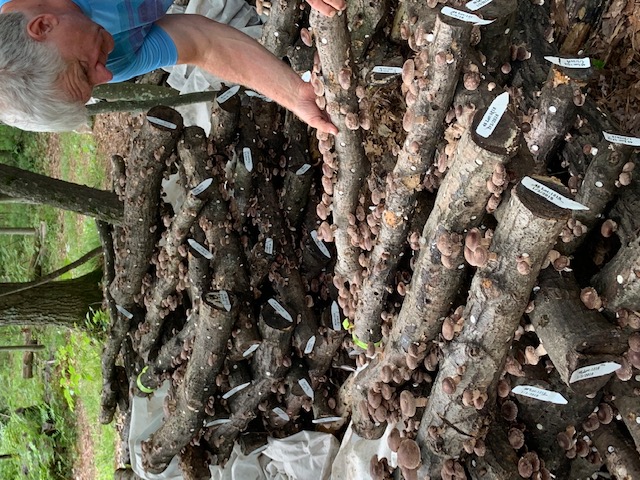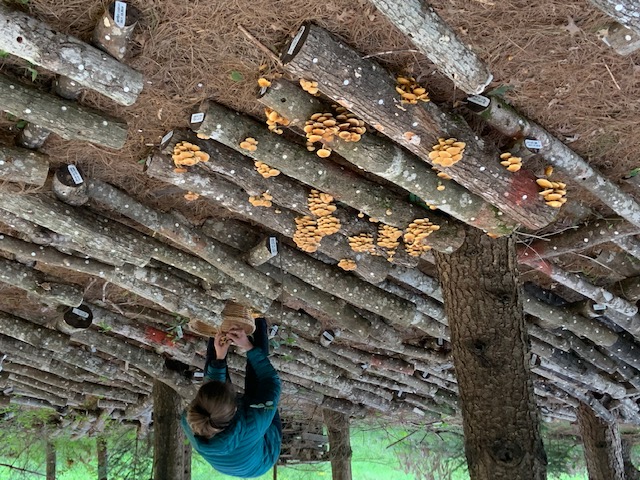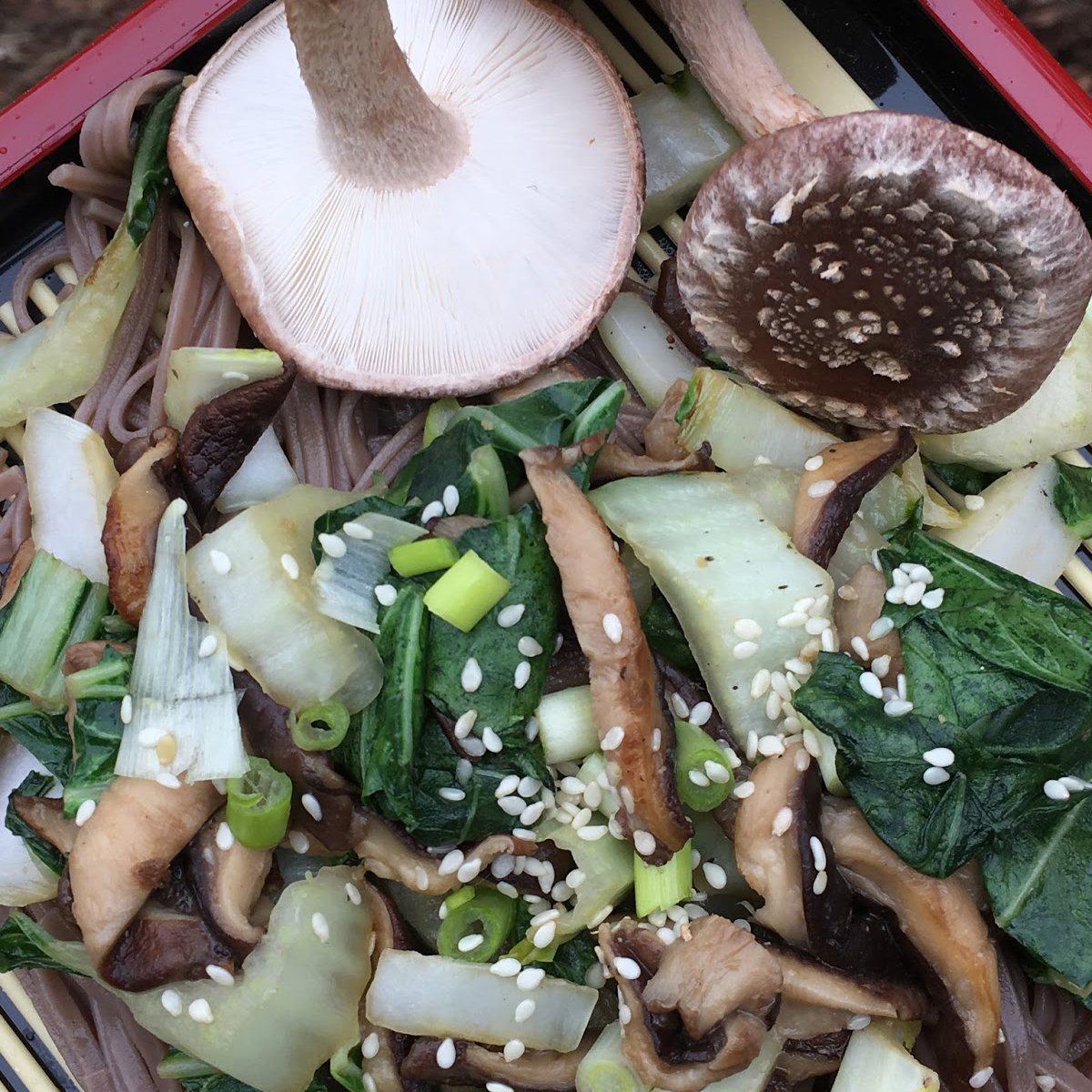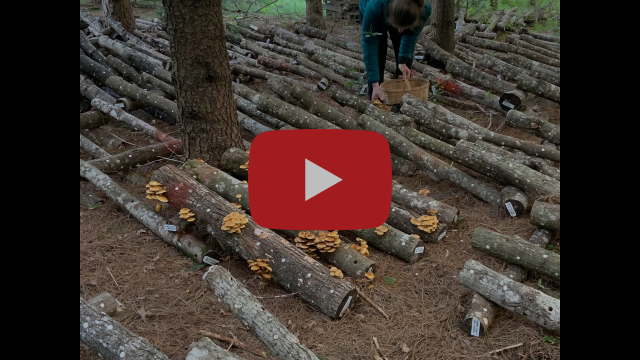
This item addresses protection and over winterting of shitaki mushrooms. This .is a natural add on to any farm operation having a woodlot to manage and cold weather as well.
The product is quickly coming into favor as well. It will easily bacome a dietary staple to provide vitimin D during the winter. The mushrooms are readily dehydrated and stored as well.
They can be added to every stew and gravy as well. The dried mushrooms can be ground up as well making it easy to augment gravies in particular.
Harvesting Shiitake mushrooms from established logs kept in a moderately High Crib Stack formation.
Protect Your Shiitake Logs with the Proper Winter Stacking Method
Overall, mushroom logs are pretty tough once they are fully colonized. Logs that were inoculated in the spring or the previous year should come through a severe winter unscathed if the logs are properly stacked. Even newly inoculated logs, if properly stacked, can hunker down into a holding phase during the deep freeze and resume growth in the spring.
When choosing an appropriate stacking configuration, you will take into account the strain, age and overall health of the log, the severity of your winters and how protected your Shiitake yard is. With all stacking methods, there is no need to tarp the logs during the winter because the logs benefit from access to rain and snowfall. When logs are covered with a non-permeable tarp overheating and condensation can occur, encouraging competitor fungi.
Here are some guidelines you can use in deciding how to stack your logs for Winter. Please refer to the video below for a visual representation. You can then adjust the stacks for the best fit for YOUR winter climate and laying yard.
1. Low Lean-To Stack. In climates with severe winters, keeping the logs low to the ground can protect them from freeze-drying winds by a blanket of snow. Logs bundled together and stacked close to the ground get minimum wind exposure. This stack is especially good for logs you've just inoculated this fall.

Chestnut mushrooms fruiting on logs in an Open Low-Lean-To Stack.
2. Open Low Lean-To Stack. For northern areas that have a lot of space in the mushroom yard, you can also try an Open Low Lean-To Stack. This is identical to the low lean-to but there are fewer logs in the course. This useful stack can be used as your primary stack immediately after inoculation in the spring, no need to re-stack to get ready for winter because the logs had all summer to colonize. The open stack also allows for easy harvest of natural fruiting early spring and late fall and can stay in this configuration permanently.
3. High Lean-To Stack. In areas that have milder winters, try a High Lean-To Stack. This is the same concept as the Low Lean-To except in gentler climates, logs don’t need to be so low to the ground, and can be stacked at a higher angle, facilitating drainage of excess rain.
4. Crib Stack. If you are short on space, try a Crib Stack. In cold, snowy areas, stack the logs in a Low Crib Stack, constructed in tight layers, with the larger diameter logs placed at the outer edges. Try not to stack taller than knee-high to keep the logs protected. This is also a good stack for newly inoculated logs, as is the Low-Lean-To Stack.
5. Open Crib Stack. Growers in mild winter climates will often just use an Open Crib Stack and often do not need to adjust the stack for winter storage because they get plenty of rain and the temperatures are not so severe.
At Field and Forest Products, we allow our logs that have been in production for over a year or more to stay in moderately high crib stack through the winter because the labor trade off to re-stack the logs just for winter-time is just too great. Plus, older logs can benefit from drying out a little during the winter.
6. A-Frame Stack. Possibly only mild weather climates should use the A-Frame Stack for winter storage, and should be used only with logs that are well colonized and have seen at least a season of good production. This stack is prone to drying and collapsing unless you are a master-stacker and have constructed a sound stacking frame.
Though the extra work of stacking and log handling may seem labor-intensive, it is an opportunity to get to know your logs just by judging their weight and bark condition as you work with them. A little time put in to learning about your logs now when you have just a few can pay off as your log population grows. Happy hefting!
How to Stack Your Mushroom Logs
for Winter Storage

Shiitake Miso Bok Choy
While the farmer’s market is winding down for winter, you can still readily find bok choy at most vegetable stands. Enjoy this savory side!
2 Tbsp. toasted sesame oil
1 Tbsp. miso paste (we prefer white)
1 Tbsp. rice vinegar
1 Tbsp. fresh ginger root, grated
1 lb. fresh Shiitake, stemmed and sliced
1 lb. bok choy
sesame seeds, cilantro or chopped scallion for garnish
cooked brown rice or soba noodles for serving
Preparation:
Heat a large Sauté pan and add oil. When warm, add mushrooms and sprinkle with a pinch of salt. Cook for a few minutes until Shiitake soften or brown slightly, depending on your preference. Add miso paste, vinegar, ginger. Toss and coat the mushrooms and then add the bok choy. Cover until the mix is bright green and soft, about 3 minutes. Spoon over rice or noodles and add garnish.
Oyster Sauce variation:
Instead of using a miso sauce, drizzle Sautéed Shiitake mushrooms with a high quality Oyster sauce until warmed through - do not overcook, a minute or two maximum! Plate and sprinkle with sesame seeds. So easy and so delicious!

No comments:
Post a Comment